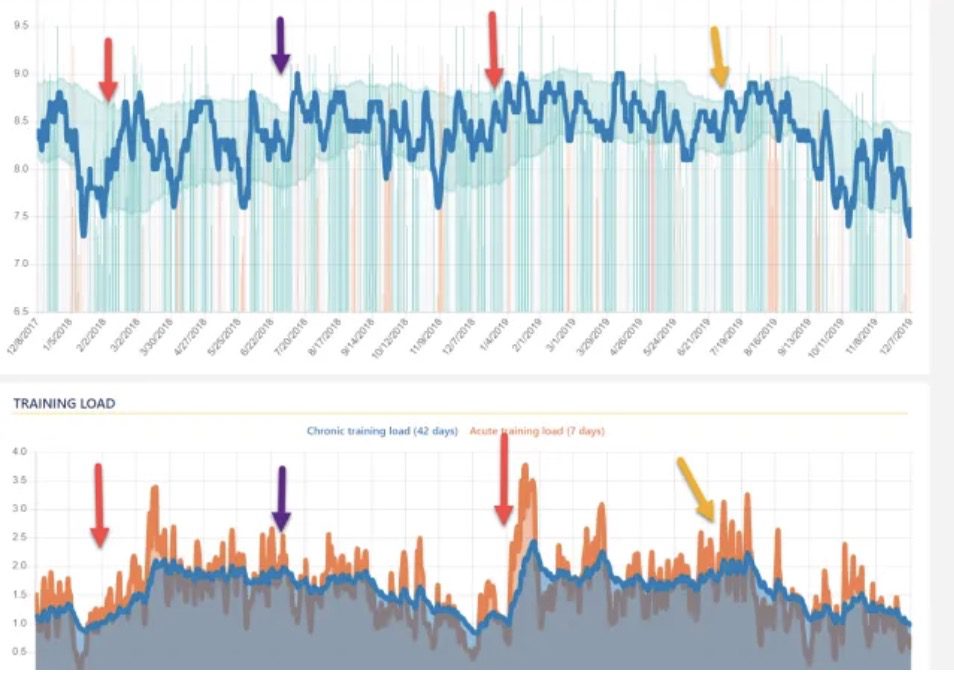Heart Rate Variability (HRV) and resting heart rate are great ways to monitor your body and get objective feedback on how your body is handling the training you are putting in. It is important (and valuable) as a gauge of your ‘fitness’ because it also does not discriminate between training stress, work stress, bad sleep stress, or 5 shots of tequila stress! This is a common criticism of TSS or other output measures that are telling you the training stress of your workout but not the stress/strain your body is experiencing from that workout nor from the above lifestyle stressors.
How to collect?
I used the HRV4Training app personally since it came out and have used it with clients, via the HRV4Training Pro platform for about 3 years now. It lets you collect HRV with that phone you always have with you by simply putting your finger on the camera for a minute … easy, no HR staps to forget, and no excuses!
I love the extra objective insight HRV/HR adds but I have said that my favorite part of the app is how it has helped many clients who were resistant to commenting on their training in trainingpeaks.com get there via syncing a ‘survey’ of subjective measures direct to TrainingPeaks.com along with resting HR and HRV.
I am starting to collect some neat data from different times of the year and different phases of life (return to school, change in job, concussions, menopause, changes of meds, and different training blocks).
HRV and Training Load
Today I wanted to share a few examples of how different types of training load, or different phases of the training year, might affect HRV.
I find consistently that HRV can be a good indicator of when we have been endurance training regularly and perhaps at similar levels to past performances. We should certainly compare and contrast to our peak powers, race results and metrics like TSS to ensure we aren’t training harder/longer simply to try and elevate our HRV to past levels. We do change as people over time and each year can be different. (refer to the 5 tequilas above)
case 1 – fall peak and off-season

Above is a pretty typical build towards a September race, then reduced training load and slowly HRV is reduced (blue line is 7 day rolling avg)
case 2 – elite … back to school

The above image has a top/bottom image included. The top is the HRV tracing and the bottom is a *rough* training load done by RPE x duration. This case is perhaps unique because this athlete has a high HRV and a very high fitness/performance level in the spring/summer. Come September a break after the main race season (and some missing data) before school starts and the routine is regular but not focused on such high and regular endurance.
case 3 – peak, bike pack, race, off

The above screenshot also has a top-bottom and this athlete raced their A-priority race in September (far left) and then wanted to keep riding while the weather was good and build towards a November event AND got coaxed into a big multi-day bike packing trip with riding most of each day.
You can see the big spike in the training stress (bottom) and the corresponding drop in the top image (HRV). The athlete’s November race was ok but there was missing the snappy workouts and lower volumes typical ahead of short/hard events that seem to lead to great race days. A trade-off that is perhaps captured in the drop in HRV and training load prior to the event (and in this case likely worth it for the great 4-day adventure!)

Finally this is two years of training and racing for an elite-level athlete where there was some injury/illness on far left before starting winter training (red arrow). Peak race in July for the first summer.
The second red arrow near the center is the most recent year’s spring training which was much harder and better absorbed. 2 Additional good camps were done and racing was generally better and more consistent. the second year was much more consistent. The yellow arrow is the 2nd summers peak event which included much more racing over the month. HRV returned to previous levels (not pictured, 3-4 years out) for the season before dropping again for the off-period (far right)
Curious about HRV?
If you are curious about HRV training please take a look at the HRV4Training APP and also their very informative blog





